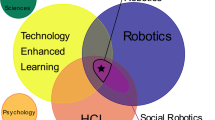Abstract
The increase of social robots in services has generated academic interest in their design and development to enhance human-robot interaction across various contexts, from home assistance to educational and medical environments. Design criteria increasingly explore the software development aspect, but interdisciplinary focus on sustainability also pursues hardware improvement for human-robot interaction in contexts ranging from home assistance to medical environments. With this background, the research question arises: What key features should be considered for the development of a social robot in academia? A systematic metadata review according to PRISMA of 698 studies from the SCOPUS database was conducted, selecting 10 relevant ones to explore functions and applications that allow characterizing hardware and software in the design of social robots for development in academia. Preliminary results indicate a focus on creating smarter, safer, and more adaptable robots, utilizing advances in hardware and software such as flexible electronics and artificial intelligence. It is concluded that the balance between hardware and software proposes the prototyping of a robotic platform with LiDAR/ROS technology, flexible electronics, and ultralightweight material structure, for sustainable, low-power consumption, and low-cost developments. Collaboration among researchers, educators, and developers is crucial to create educational social robots that are both useful and accepted.
Access this chapter
Tax calculation will be finalised at checkout
Purchases are for personal use only
Similar content being viewed by others
References
Youssef, K., Said, S., Alkork, S., Beyrouthy, T.: Social robotics in education a survey on recent studies and applications. Int. J. Emerg. Technol. Learn. 18(3), 67–82 (2023). https://doi.org/10.3991/IJET.V18I03.33529
Nocentini, O., Fiorini, L., Acerbi, G., Sorrentino, A., Mancioppi, G., Cavallo, F.: A survey of behavioral models for social robots. Robotics 8(3) (2019). https://doi.org/10.3390/robotics8030054
Mayer, H.: RoboLabs: building surfaces of intelligibility. Front. Artif. Intell. Appl. 335, 27–39 (2020). https://doi.org/10.3233/FAIA200898
Maples, B., Pea, R.D., Markowitz, D.: Learning from intelligent social agents as social and intellectual mirrors. In: AI in Learning: Designing the Future, pp. 73–89, January 2022. https://doi.org/10.1007/978-3-031-09687-7_5/COVER
Rossi, A., Dautenhahn, K., Koay, K.L., Walters, M.L.: 2020 29th IEEE International Conference on Robot and Human Interactive Communication (RO-MAN). IEEE (2020)
Mende, M., Scott, M.L., van Doorn, J., Grewal, D., Shanks, I.: Service robots rising: how humanoid robots influence service experiences and elicit compensatory consumer responses. J. Market. Res. 56(4), 535–556 (2019). https://doi.org/10.1177/0022243718822827
Annamalai, N., Rashid, R.A., Munir Hashmi, U., Mohamed, M., Harb Alqaryouti, M., Eddin Sadeq, A.: Using chatbots for English language learning in higher education. Comput. Educ. Artif. Intell. 5, 100153 (2023). https://doi.org/10.1016/J.CAEAI.2023.100153
Vaganova, O.I., Smirnova, Z.V., Kamenez, N.V., Bulaeva, M.N., Kutepov, M.M.: Organization of educational activities of volunteers as a social and educational project. Hum. Soc. Sci. Rev. 7(3), 585–589 (2019). https://doi.org/10.18510/hssr.2019.7387
Ilori, M.O., Ajagunna, I.: Re-imagining the future of education in the era of the fourth industrial revolution. Worldwide Hosp. Tour. Themes 12(1), 3–12 (2020). https://doi.org/10.1108/WHATT-10-2019-0066
Lopez-Caudana, E., Lopez-Orozco, C.F., Bárbara, C.M., Reyes, G.E.B., Ponce, P., Chong-Quero, J.E.: Physical therapy using robotics: a project-based learning experience for undergraduate students. Australas. J. Educ. Technol. 37(5), 32–42 (2021). https://doi.org/10.14742/ajet.7139
Ponce, P., López-Orozco, C.F., Reyes, G.E.B., Lopez-Caudana, E., Parra, N.M., Molina, A.: Use of robotic platforms as a tool to support STEM and physical education in developed countries: a descriptive analysis. Sensors 22(3) (2022). https://doi.org/10.3390/s22031037
Arora, A.S., Arora, A., Sivakumar, K., Taras, V.: The role of anthropomorphic, xˆenocentric, intentional, and social (AXˆIS) robotics in human-robot interaction. Comput. Hum. Behav. Artif. Hum. 2(1), 100036 (2024). https://doi.org/10.1016/J.CHBAH.2023.100036
Brynjolfsson, E.: The turing trap: the promise & peril of human-like artificial intelligence. Daedalus 151(2), 272–287 (2022). https://doi.org/10.1162/DAED_A_01915
Bartneck, C., Kulić, D., Croft, E., Zoghbi, S.: Measurement instruments for the anthropomorphism, animacy, likeability, perceived intelligence, and perceived safety of robots. Int. J. Soc. Robot. 1(1), 71–81 (2009). https://doi.org/10.1007/S12369-008-0001-3
Koceska, N., Koceski, S., Zobel, P.B., Trajkovik, V., Garcia, N.: A telemedicine robot system for assisted and independent living. Sensors (Switzerland) 19(4) (2019). https://doi.org/10.3390/s19040834
Meghdari, A., Alemi, M., Zakipour, M., Kashanian, S.A.: Design and realization of a sign language educational humanoid robot. J. Intell. Robot. Syst. Theory Appl. 95(1), 3–17 (2019). https://doi.org/10.1007/s10846-018-0860-2
Benitez, V.H., Symonds, R., Elguezabal, D.E.: Design of an affordable IoT open-source robot arm for online teaching of robotics courses during the pandemic contingency. HardwareX 8 (2020). https://doi.org/10.1016/j.ohx.2020.e00158
Lima, M.R., Wairagkar, M., Natarajan, N., Vaitheswaran, S., Vaidyanathan, R.: Robotic telemedicine for mental health: a multimodal approach to improve human-robot engagement. Front Robot AI 8 (2021). https://doi.org/10.3389/frobt.2021.618866
Zhao, D., Zhu, Y., Cheng, W., Chen, W., Wu, Y., Yu, H.: Cellulose-based flexible functional materials for emerging intelligent electronics. Adv. Mater. 33(28) (2021). https://doi.org/10.1002/adma.202000619
Martin, J.G., Frejo, J.R.D., García, R.A., Camacho, E.F.: Multi-robot task allocation problem with multiple nonlinear criteria using branch and bound and genetic algorithms. Intell. Serv. Robot. 14(5), 707–727 (2021). https://doi.org/10.1007/s11370-021-00393-4
Sugiura, K., Matsutani, H.: A universal LiDAR SLAM accelerator system on low-cost FPGA. IEEE Access 10, 26931–26947 (2022). https://doi.org/10.1109/ACCESS.2022.3157822
Fraga-Lamas, P., Barros, D., Lopes, S.I., Fernández-Caramés, T.M.: Mist and edge computing cyber-physical human-centered systems for Industry 5.0: a cost-effective IoT thermal imaging safety system. Sensors 22(21) (2022). https://doi.org/10.3390/s22218500
Koh, W.Q., Whelan, S., Heins, P., Casey, D., Toomey, E., Droes, R.-M.: The usability and impact of a low-cost pet robot for older adults and people with dementia: qualitative content analysis of user experiences and perceptions on consumer websites. JMIR Aging 5(1) (2022). https://doi.org/10.2196/29224
Chaka, C.: Fourth industrial revolution—a review of applications, prospects, and challenges for artificial intelligence, robotics and blockchain in higher education. Res. Pract. Technol. Enhanc. Learn. 18 (2023). https://doi.org/10.58459/rptel.2023.18002
Author information
Authors and Affiliations
Corresponding author
Editor information
Editors and Affiliations
Rights and permissions
Copyright information
© 2024 The Author(s), under exclusive license to Springer Nature Switzerland AG
About this paper
Cite this paper
Zapata, M., Álvarez-Tello, J. (2024). Social Robots for Service Environments in Academia. In: Stephanidis, C., Antona, M., Ntoa, S., Salvendy, G. (eds) HCI International 2024 Posters. HCII 2024. Communications in Computer and Information Science, vol 2114. Springer, Cham. https://doi.org/10.1007/978-3-031-61932-8_48
Download citation
DOI: https://doi.org/10.1007/978-3-031-61932-8_48
Published:
Publisher Name: Springer, Cham
Print ISBN: 978-3-031-61931-1
Online ISBN: 978-3-031-61932-8
eBook Packages: Computer ScienceComputer Science (R0)




